Plymouth Argyle
Although the club takes 1886 as the year of its foundation, it is now known that the original Argyle FC went out of existence in 1894. Formed by F Howard Grose and W Pethybridge, the team was made up of former public school boys and servicemen at a meeting in a house in Argyll Terrace. The club's web site suggests a connection with the Argyll & Sutherland Highlanders who were at that time stationed in Plymouth and who had impressed Grose by winning the Army Cup but this version has been questioned. The club's unusual green and black colours are those of the Borough of Plymouth and not the the tartan worn by the Scottish regiment, as has been suggested.
The modern club was formed in 1897, inheriting both the name and colours of the original club. With financial backing from Clarence Newby Spooner, whose family owned a large department store in the town, Argyle became a football and athletic club, broadening its membership and purchasing a ground at Marsh Mill. In 1900 the club won its first honour, the Devon Senior League championship. That same year Argyle purchased the lease on Home Park, which remains their ground to this day. Two years later the club turned semi-professional and top League clubs were invited to play friendlies at Home Park. Such was the interest generated that when Argyle applied to join the Southern League in May 1903, they were voted straight into the First Division. Despite its isolated position, lengthy travel and competition from rugby union (a very popular sport in the West Country), Argyle thrived and won the Southern League championship in 1913, finishing as runners-up twice. The club are known as "the Pilgrims" because of local connections with the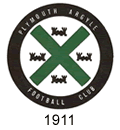 Pilgrim fathers who sailed in the Mayflower from Plymouth to New England in 1620.
Pilgrim fathers who sailed in the Mayflower from Plymouth to New England in 1620.
In the years leading up to the Great War a crest was worn by the team. This featured four turrets and the cross of St Andrew (to whom the city's mother church is dedicated) from the city coat of arms.
In 1920 Plymouth Argyle along with the rest of the top Southern League clubs joined the new Third Division of the Football League. The club finished as runners-up no fewer than six times in succession between 1922 and 1927 but in those days only the champions of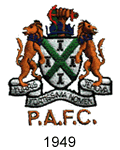 the regional divisions were promoted. The frustration ended in 1930 when the club were finally crowned champions of Division Three (South). After a stay of twenty years in Division Two, the Pilgrims were relegated in 1950 but returned to the Second Division only two years later.
the regional divisions were promoted. The frustration ended in 1930 when the club were finally crowned champions of Division Three (South). After a stay of twenty years in Division Two, the Pilgrims were relegated in 1950 but returned to the Second Division only two years later.
From 1949 the city's coat arms were worn with the addition of the club's initials. 1956 brought relegation once again and this time it took three years for the club to regain its Second Division status.
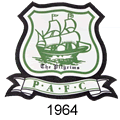 There was little to cheer during the 1960s although the club did adopt an elegant white strip with black and green bands, the first of many highly distinctive outfits worn by the club over the last 40 years. This landmark strip also saw the introduction a modern club crest with "The Mayflower" as the centre piece.
There was little to cheer during the 1960s although the club did adopt an elegant white strip with black and green bands, the first of many highly distinctive outfits worn by the club over the last 40 years. This landmark strip also saw the introduction a modern club crest with "The Mayflower" as the centre piece.
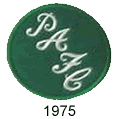 In 1968, Argyle dropped back into Division Three where they spent six seasons before winning promotion in 1975 only to suffer relegation once again in 1977.
In 1968, Argyle dropped back into Division Three where they spent six seasons before winning promotion in 1975 only to suffer relegation once again in 1977.
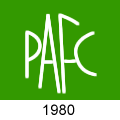 The Mayflower crest was dropped in 1973 in favour of a simple monogramme stitched in white. The all white strip worn in 1975-76 had the lettering embroidered onto a green disc. Green shirts were reinstated in 1978 (an alternative version with the old crest was worn at least once, at Chesterfield on 19 August) and when Adidas took over in 1980, the lettering was embroidered in an angular style rather than the more traditional script.
The Mayflower crest was dropped in 1973 in favour of a simple monogramme stitched in white. The all white strip worn in 1975-76 had the lettering embroidered onto a green disc. Green shirts were reinstated in 1978 (an alternative version with the old crest was worn at least once, at Chesterfield on 19 August) and when Adidas took over in 1980, the lettering was embroidered in an angular style rather than the more traditional script.
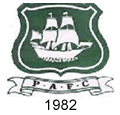 Between 1982 and 1987 the club's kits were supplied by a local firm, appropriately called "Pilgrim" - a number of other teams in the south-west, notably Torquay also wore Pilgrim kits at this time. Pilgrim's outfits saw the welcome reintroduction of the Mayflower crest.
Between 1982 and 1987 the club's kits were supplied by a local firm, appropriately called "Pilgrim" - a number of other teams in the south-west, notably Torquay also wore Pilgrim kits at this time. Pilgrim's outfits saw the welcome reintroduction of the Mayflower crest.
In 1984, while still in the Third Division, Argyle reached the FA Cup semi-final where they were narrowly beaten by Elton John's Watford. Promotion to Division Two followed in 1986 but in 1992 they club was relegated yet again. In 1995 Plymouth dropped into the Nationwide Third Division (the old Fourth Division), the first time the club had ever been in the lowest division.
Although the club won promotion at the first attempt, they were back in the basement in 1998. For the 2000-01 season, the previous season's white shirts with narrow green stripes were adopted as the team's first choice strip.
After winning the Nationwide Third Division championship at a canter in 2002 and then the Nationwide Second Division in 2004, Argyle regained their traditional place in what is now called "The Championship" (the old Second Division.)
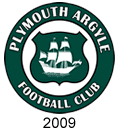 In 2001 the board decided to select a dark Racing Green shade (Pantone 3308) and the team have worn this ever since. After 45 years, the board decided to update the popular club crest in 2009 although they wisely retained the key motif.
In 2001 the board decided to select a dark Racing Green shade (Pantone 3308) and the team have worn this ever since. After 45 years, the board decided to update the popular club crest in 2009 although they wisely retained the key motif.
After finishing in the top half of the Championship in 2007, Argyle slipped towards a serious financial crisis. They were relegated in 2009 with a transfer embargo in place due to their failure to pay their tax bill. In 2010-11, Argyle sold off their best players and handed over their share of the Football League's broadcast contract to The Revenue to avoid a winding up order over £760,000 in unpaid tax. By the time this was concluded the club had run up a further £300,000 in unpaid tax and in order to avoid a third winding up order, issued notice of intention to enter administration. This incurred an automatic ten-point penalty that landed them at the bottom of League One, eight points adrift.
In July 2011 Peter Ridsdale, who had joined the club as "football consultant" the previous December before becoming acting chairman in March, announced that he had brokered a deal to sell the club's ground and surrounding land to a Gibraltar-based consortium, Bishop International Ltd. Ridsdale would then pay just £1 to become the sole shareholder of the new company controlling the club. The Argyle Supporters' Trust, unhappy with the involvement of the 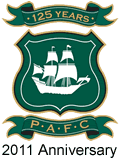 Truro City chairman in advising BIL, wrote to the administrator urging him to consider an alternative bid but with just a few weeks before the start of the season, while staff and players had not been paid their salaries in full since March, Ridsdale's plan seemed the only viable option.
Truro City chairman in advising BIL, wrote to the administrator urging him to consider an alternative bid but with just a few weeks before the start of the season, while staff and players had not been paid their salaries in full since March, Ridsdale's plan seemed the only viable option.
Whilst in administration Argyle were unable to negotiate a new kit deal so in July it was announced they would start the 2011-12 season in a standard Puma training strip pending delivery of new kits in September. 2011 also marked the club's 125th anniversary for which a special crest was commissioned but for supporters this was scant compensation for the ruin of their club.
When funds promised by BIL failed to materialise (and after manager Peter Reid, who had sold his own FA Cup medals to pay the utility bills had been sacked), the administrators belatedly agreed to consider an alternative bid from local hotelier, James Brent who headed up the Akkeron Group. Due to this delay, the temporary strips that were supposed to be replaced in September became permanent when Brent finally took over and Argyle came out of administration in October. Two months later Ridsdale left to sprinkle his magic over Preston.
